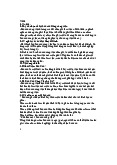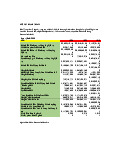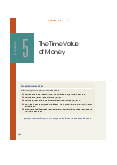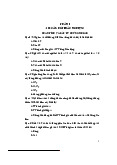



















Preview text:
Solutions Session 2 - Chapter 2 Basic 1.
To find owners’ equity, we must construct a balance sheet as follows: Balance Sheet CA $ 5,400 CL $ 4,100 NFA 28,100 LTD 10,600 OE ?? TA $33,500 TL & OE $33,500
We know that total liabilities and owners’ equity (TL & OE) must equal total assets of $33,500. We
also know that TL & OE is equal to current liabilities plus long-term debt plus owners’ equity, so owners’ equity is:
Owners’ equity = $33,500 – 10,600 – 4,100 Owners’ equity = $18,800
And net working capital (NWC) is: NWC = CA – CL NWC = $5,400 – 4,100 NWC = $1,300 2.
The income statement for the company is: Income Statement Sales $497,000 Costs 276,000 Depreciation 43,000 EBIT $178,000 Interest 24,000 EBT $154,000 Taxes 32,340 Net income $121,660
One equation for net income is:
Net income = Dividends + Addition to retained earnings Rearranging, we get:
Addition to retained earnings = Net income – Dividends
Addition to retained earnings = $121,660 – 30,000
Addition to retained earnings = $91,660 3.
To find the book value of current assets, we use: NWC = CA – CL. Rearranging to solve for current assets, we get: CA = NWC + CL CA = $275,000 + 945,000 CA = $1,220,000
The market value of current assets and fixed assets is given, so: Book value CA $1,220,000 Market value NWC $1,250,000 Book value NFA 3,500,000 Market value NFA 5,400,000 Book value assets $4,720,000 Total $6,650,000 4.
Taxes = .10($9,950) + .12($40,525 – 9,950) + .22($86,375 – 40,525) + .24($164,925 – 86,375) + .32($189,000 – 164,925) Taxes = $41,307
The average tax rate is the total tax paid divided by taxable income, so:
Average tax rate = $41,307/$189,000
Average tax rate = .2186, or 21.86%
The marginal tax rate is the tax rate on the next $1 of earnings, so the marginal tax rate is 32 percent. 5.
To calculate OCF, we first need the income statement: Income Statement Sales $49,800 Costs 23,700 Depreciation 2,300 EBIT $23,800 Interest 1,800 Taxable income $22,000 Taxes (22%) 4,840 Net income $17,160
OCF = EBIT + Depreciation – Taxes
OCF = $23,800 + 2,300 – 4,840 OCF = $21,260 6.
Net capital spending = NFAend – NFAbeg + Depreciation
Net capital spending = $3,100,000 – 2,300,000 + 327,000
Net capital spending = $1,127,000 7.
The long-term debt account will increase by $34 million, the amount of the new long-term debt
issue. Since the company sold 4.6 million new shares of stock with a $1 par value, the common
stock account will increase by $4.6 million. The capital surplus account will increase by $56.4
million, the value of the new stock sold above its par value. Since the company had a net income of
$7.9 million, and paid $1.9 million in dividends, the addition to retained earnings was $6 million,
which will increase the accumulated retained earnings account. So, the new long-term debt and
stockholders’ equity portion of the balance sheet will be: Long-term debt $ 82,000,000 Total long-term debt $ 82,000,000 Shareholders’ equity Preferred stock $ 3,100,000 Common stock ($1 par value) 16,100,000 Accumulated retained earnings 114,000,000 Capital surplus 107,400,000 Total equity $ 240,600,000 Total liabilities & equity $ 322,600,000 8.
Cash flow to creditors = Interest paid – Net new borrowing
Cash flow to creditors = Interest paid – (LTDend – LTDbeg)
Cash flow to creditors = $305,000 – ($2,660,000 – 2,250,000)
Cash flow to creditors = –$105,000 9.
Cash flow to stockholders = Dividends paid – Net new equity
Cash flow to stockholders = Dividends paid – [(Commonend + APISend) – (Commonbeg + APISbeg)]
Cash flow to stockholders = $654,000 – [($965,000 + 5,040,000) – ($780,000 + 4,780,000)]
Cash flow to stockholders = $209,000
Note, APIS is the additional paid-in surplus. 10. Cash flow from assets
= Cash flow to creditors + Cash flow to stockholders
= –$105,000 + 209,000 = $104,000 Cash flow from assets
= $104,000 = OCF – Change in NWC – Net capital spending
= $104,000 = OCF – (–$55,000) – 1,500,000 Operating cash flow
= $104,000 – 55,000 + 1,500,000 Operating cash flow = $1,549,000 Intermediate 11. a.
The accounting statement of cash flows explains the change in cash during the year. The
accounting statement of cash flows will be: Statement of cash flows Operations Net income $148 Depreciation 94
Changes in other current assets –18 Change in accounts payable 18
Total cash flow from operations $242 Investing activities Acquisition of fixed assets –$114
Total cash flow from investing activities –$114 Financing activities Proceeds of long-term debt $9 Dividends –115
Total cash flow from financing activities –$106
Change in cash (on balance sheet) $22 b.
Change in NWC = NWCend – NWCbeg
= (CAend – CLend) – (CAbeg – CLbeg)
= [($87 + 195) – 149] – [($65 + 177) – 131] = $133 – 111 = $22 c.
To find the cash flow generated by the firm’s assets, we need the operating cash flow and the
capital spending. So, calculating each of these, we find: Operating cash flow Net income $148 Depreciation 94 Operating cash flow $242
Note that we can calculate OCF in this manner since there are no taxes. Capital spending Ending fixed assets $420 Beginning fixed assets –400 Depreciation 94 Capital spending $114
Now we can calculate the cash flow generated by the firm’s assets, which is: Cash flow from assets Operating cash flow $242 Capital spending –114 Change in NWC –22 Cash flow from assets $106 12.
With the information provided, the total of capital spending and the change in net working capital are:
Cash flows from the firm Capital spending –$27,500 Additions to NWC –2,600
Capital spending and NWC cash flow –$30,100
And the cash flows to the investors of the firm are:
Cash flows to investors of the firm Sale of long-term debt –$13,800 Sale of common stock –5,000 Dividends paid 13,800
Cash flows to investors of the firm –$5,000 13. a.
The interest expense for the company is the amount of debt times the interest rate on the
debt. So, the income statement for the company is: Income Statement Sales $895,000 Cost of goods sold 461,000 Selling costs 215,000 Depreciation 108,000 EBIT $111,000 Interest 27,400 Taxable income $ 83,600 Taxes 17,556 Net income $ 66,044 b.
And the operating cash flow is:
OCF = EBIT + Depreciation – Taxes
OCF = $111,000 + 108,000 – 17,556 OCF = $201,444 14.
To find the OCF, we first calculate net income. Income Statement Sales $336,000 Costs 194,700 Other expenses 9,800 Depreciation 20,600 EBIT $110,900 Interest 14,200 Taxable income $96,700 Taxes 21,275 Net income $ 75,425 Dividends $21,450 Additions to RE $53,975
a. OCF = EBIT + Depreciation – Taxes
OCF = $110,900 + 20,600 – 21,275 OCF = $110,225
b. CFC = Interest – Net new LTD




